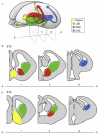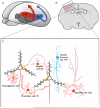The developmental integration of cortical interneurons into a functional network
- PMID: 19427517
- PMCID: PMC4465088
- DOI: 10.1016/S0070-2153(09)01203-4
The developmental integration of cortical interneurons into a functional network
Abstract
The central goal of this manuscript is to survey our present knowledge of how cortical interneuron subtypes are generated. To achieve this, we will first define what is meant by subtype diversity. To this end, we begin by considering the mature properties that differentiate between the different populations of cortical interneurons. This requires us to address the difficulties involved in determining which characteristics allow particular interneurons to be assigned to distinct subclasses. Having grappled with this thorny issue, we will then proceed to review the progressive events in development involved in the generation of interneuron diversity. Starting with their origin and specification within the subpallium, we will follow them up through the first postnatal weeks during their integration into a functional network. Finally, we will conclude by calling the readers attention to the devastating consequences that result from developmental failures in the formation of inhibitory circuits within the cortex.
Figures





References
-
- Aboitiz F, Montiel J. Co-option of signaling mechanisms from neural induction to telencephalic patterning. Rev. Neurosci. 2007;18:311–342. - PubMed
-
- Alcamo EA, Chirivella L, Dautzenberg M, Dobreva G, Farinas I, Grosschedl R, McConnell SK. Satb2 regulates callosal projection neuron identity in the developing cerebral cortex. Neuron. 2008;57:364–377. - PubMed
-
- Anderson SA, Eisenstat DD, Shi L, Rubenstein JL. Interneuron migration from basal forebrain to neocortex: Dependence on Dlx genes [see comment] Science. 1997a;278:474–476. - PubMed
-
- Anderson SA, Kaznowski CE, Horn C, Rubenstein JL, McConnell SK. Distinct origins of neocortical projection neurons and interneurons in vivo. Cereb. Corte. 2002;12:702–709. - PubMed
Publication types
MeSH terms
Substances
Grants and funding
LinkOut - more resources
Full Text Sources
Other Literature Sources

